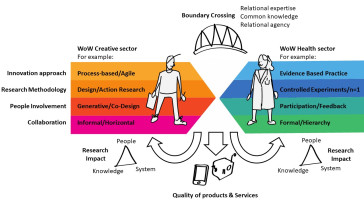Wat dragen creatieve onderzoeksmethodes bij aan vernieuwing binnen de zorg? We onderzoeken dit binnen tien projecten van het Create Health-programma van ZonMw. In deze projecten wordt kennis ontwikkeld over de toegevoegde waarde van creatieve manieren van werken bij e-health innovatie.

Wat dragen creatieve onderzoeksmethodes bij aan vernieuwing binnen de zorg? We onderzoeken dit binnen tien projecten van het Create Health-programma van ZonMw. In deze projecten wordt kennis ontwikkeld over de toegevoegde waarde van creatieve manieren van werken bij e-health innovatie. Informatie over de onderzoeksresultaten is te vinden op de website: husite.nl/creatieve-onderzoeksmethodes en het artikel: CHIWaWA maakt samenwerking in create-health onderzoek inzichtelijk | Hogeschool Utrecht (hu.nl)Doel Het Create Health programma heeft tot doel om bij te dragen aan maatschappelijke uitdagingen rondom gezond en actief ouder worden. CHIWaWA werkt daarbij toe naar een conceptueel model dat manieren van werken in kaart brengt in create health projecten – gekoppeld aan theorie over boundary crossing en research impact – met betrekking tot projectuitkomsten en kennis-, persoonlijke-, en systeemontwikkeling van betrokken actoren. Resultaten onderzoek Kennis die zowel online als offline te raadplegen is, in een boek, in wetenschappelijke artikelen en op een website. Deze kennis bevat: Inzicht in kansen om impact van e-health innovatie in ‘create health’-samenwerking te vergroten; Projectnarratieven met ‘best practices’ voor interdisciplinaire samenwerking waarbij onderzoekers, creatieve industrie en zorgprofessionals betrokken zijn; Guidelines voor ontwikkelaars van e-health applicaties m.b.t. samenwerking met de creatieve industrie; Guidelines voor beleidsmakers m.b.t. het stimuleren van samenwerking tussen zorg en creatieve industrie en het gebruik van creatieve manieren van werken om onderzoek naar de praktijk te krijgen; Aanpak Vanuit een service-dominant logic perspectief wordt bekeken hoe toegepaste kennis en skills worden gedeeld tussen actoren die betrokken zijn bij de verschillende ‘create health’-projecten, wat de meerwaarde daarvan is en wat actoren van die uitwisseling – als proces – leren. De focus ligt op co-creatie van waarde, die door samenwerking en uitwisseling tot stand komt. Door middel van procesonderzoek wordt er toegewerkt naar bijdragen aan theorieontwikkeling op het gebied van boundary crossing en contribution mapping. Resultaten Eindpublicatie: Create Health: Samenwerking tussen zorg, wetenschap en creatieve industrie (2023) Boek: Create Ways of Working. Insights from ten ehealth Innovation research projects (2022) Website www.creatieveonderzoeksmethodes.nl (2022) Bijdragen aan conferenties en symposia Co-design in de anderhalvemetermaatschappij (whitepaper), Dutch Design Week 2020. Download de presentatieslides. Collaborating in complexity. Strategies for interdisciplinary collaboration n design work, Design4Health conference 2020 Grounding Practices. How researchers ground their work in create-health collaborations for designing e-health solutions, Design4Health conference 2020 Seven ways to foster interdisciplinary collaboration in research involving healthcare and creative research disciplines, DementiaLab conference 2019 Posterpresentatie: Health x Design, DementiaLab conference 2019 Meer informatie over het Create Health programma Het ZonMw programma Create Health heeft als doel om bij te dragen aan de maatschappelijke uitdaging rondom gezond en actief ouder worden. Binnen het programma worden activiteiten uitgezet waarbij de samenwerking tussen de creatieve industrie en zorg en welzijn voorop staat. Het gaat hierbij om publiek-private samenwerking (PPS).